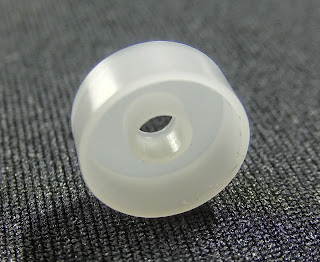前回から4ヶ月も経ってしまいましたが,スリップ角に関する続きを詳しく書きます.
前回はスリップ角が
β = θr - θm ...(1)
であること,遠心力に比例すると仮定すれば
acen = k × β ...(2)
と表されることを書きました.
遠心加速度acenは速度vと旋回半径rを使って,
acen = v2/r ...(3)
であるので式(2), (3)から
v2/r = kβ ...(4)
を得ます.
機体の角度θrの時間微分は角速度ωであり,
移動方向の角度θmの時間微分はv/rなので,
式(1)を時間微分すると,
dβ/dt = ω - v/r ...(5)
となります.
式(4)を使って式(5)からrを消去すると,
dβ/dt = -kβ/v + ω ...(6)
を得ます.
定数kを経験的に与える必要はありますが,スリップ角βの微分方程式を得られました.
これを積分すれば,スリップ角を推定することができます.
式(1)から実際の移動方向θmを得ることができますので
前々回に示した普通のオドメトリの方法で自己位置推定ができます.
I write the detail of slip angle, though four months elapsed from last time...
In the last post, it is explained that slip angle is defined as
β = θr - θm ...(1),
and the following equation can be obtained by assuming a proportional relationship between slip angle and centrifugal force,
acen = k × β ...(2).
Using velocity v and turning radius r,
centrifugal acceleration acen becomes
acen = v2/r ...(3).
So, equations (2) and (3) give
v2/r = kβ ...(4).
Here, the temporal differential of the direction of the robot θr is angular velocity ω, and
the temporal differential of the direction of actual movement θm is v/r.
Therefore,
the temporal differential of equation (1) gives
dβ/dt = ω - v/r ...(5).
Using equation (4) to erase r in equation (5),
dβ/dt = -kβ/v + ω ...(6)
can be obtained, which is the differential equation of slip angle β.
Although the constant k is required to be determined empirically,
slip angle can be estimated by integrating this equation.
Since the actual moving direction θm can be obtained by equation (1),
general odometry method gives the location of the robot, which is shown in
the post before last.













